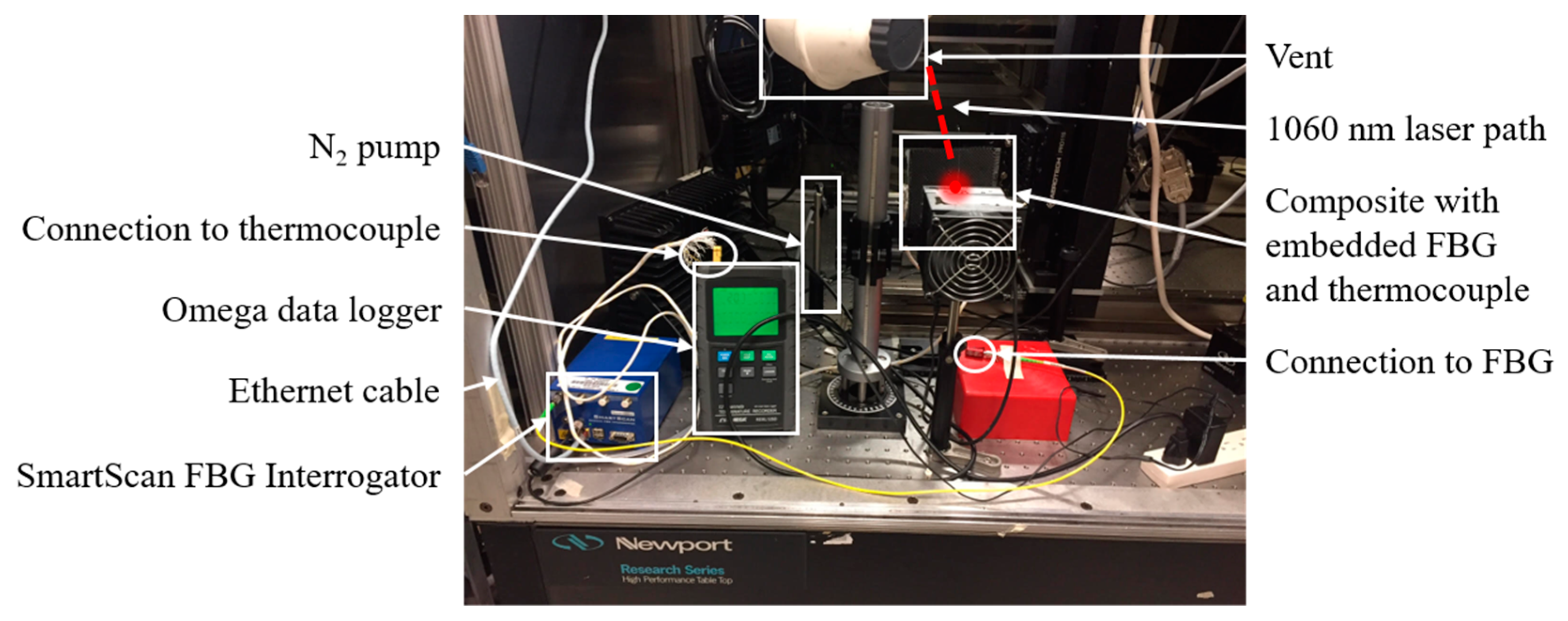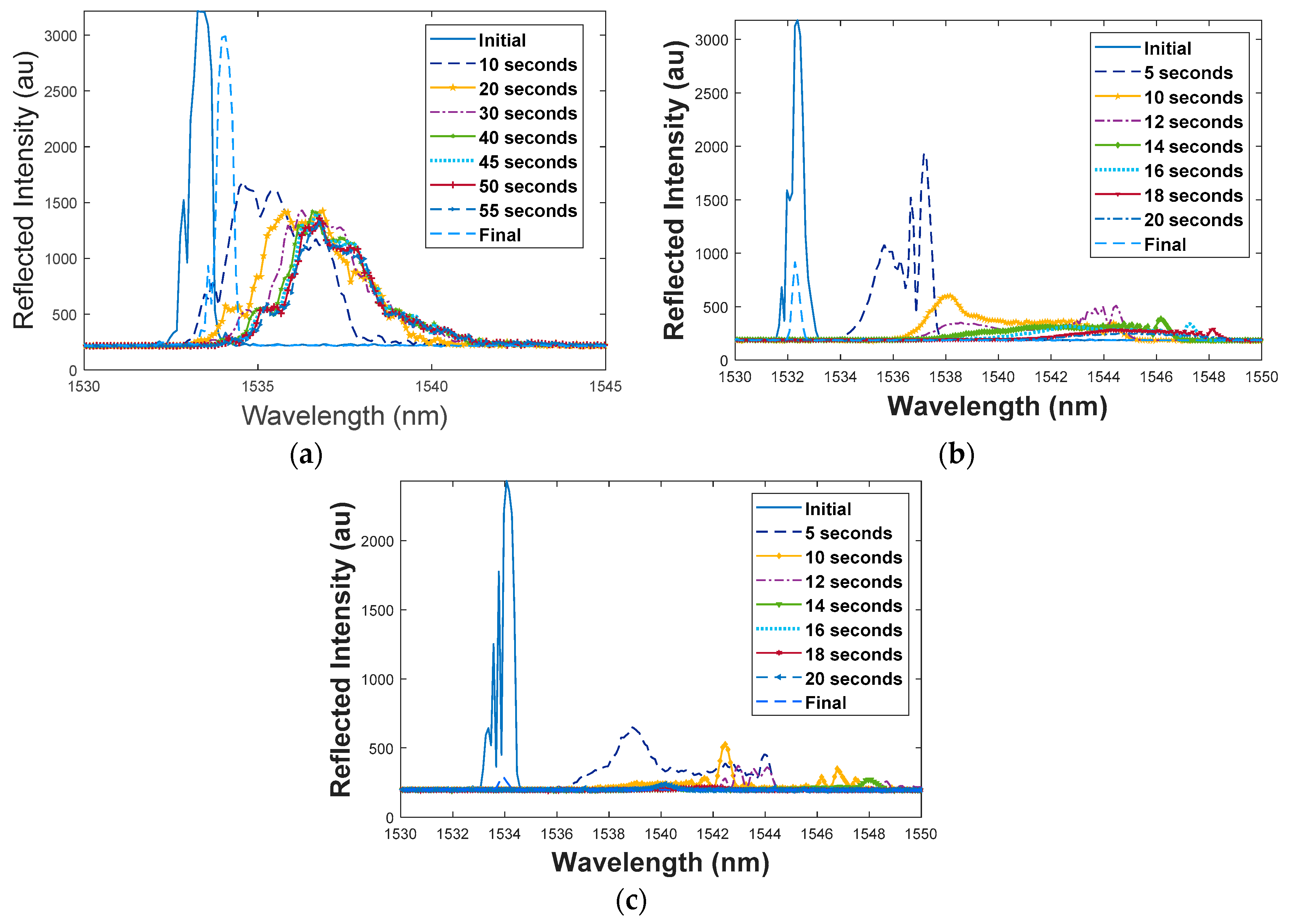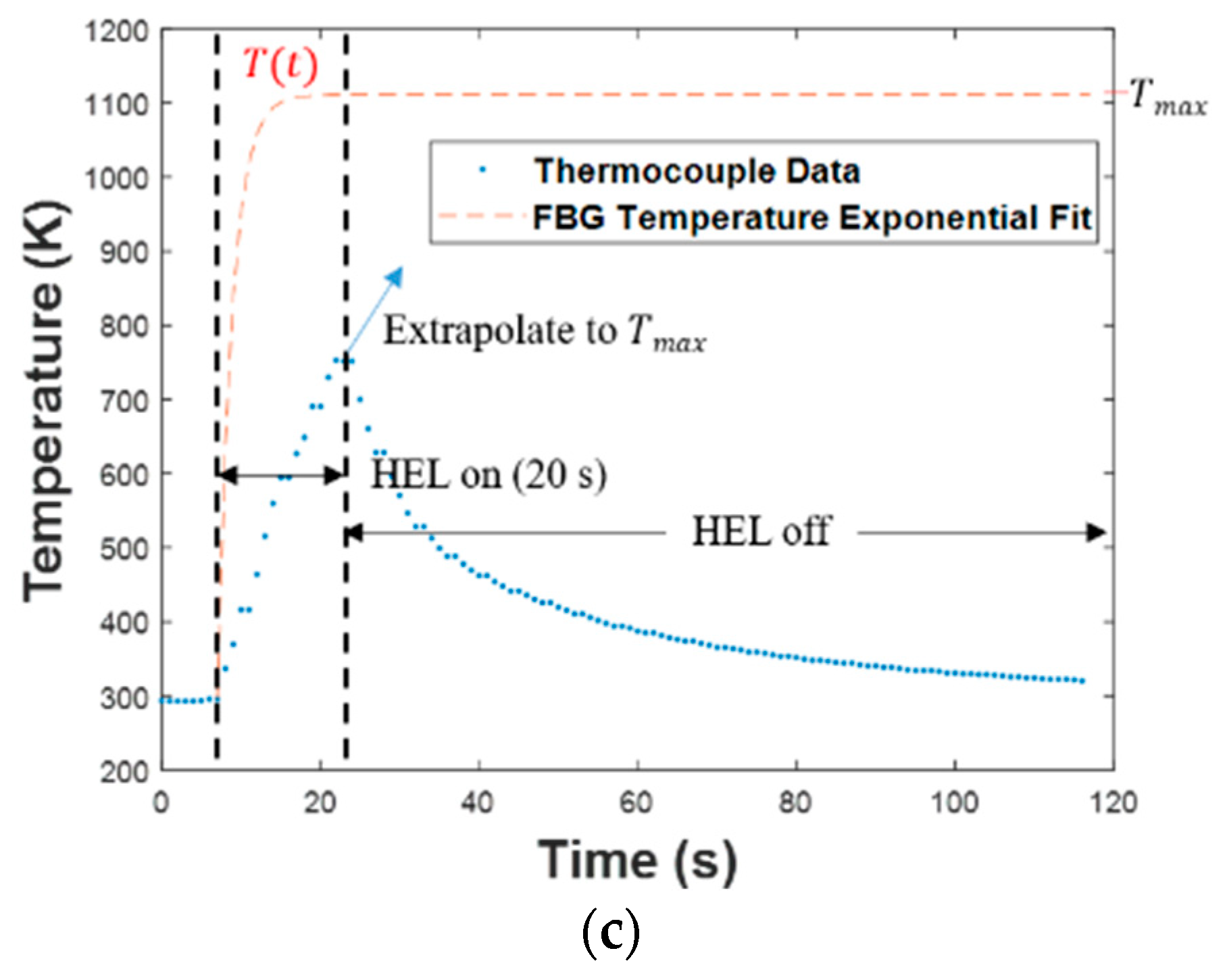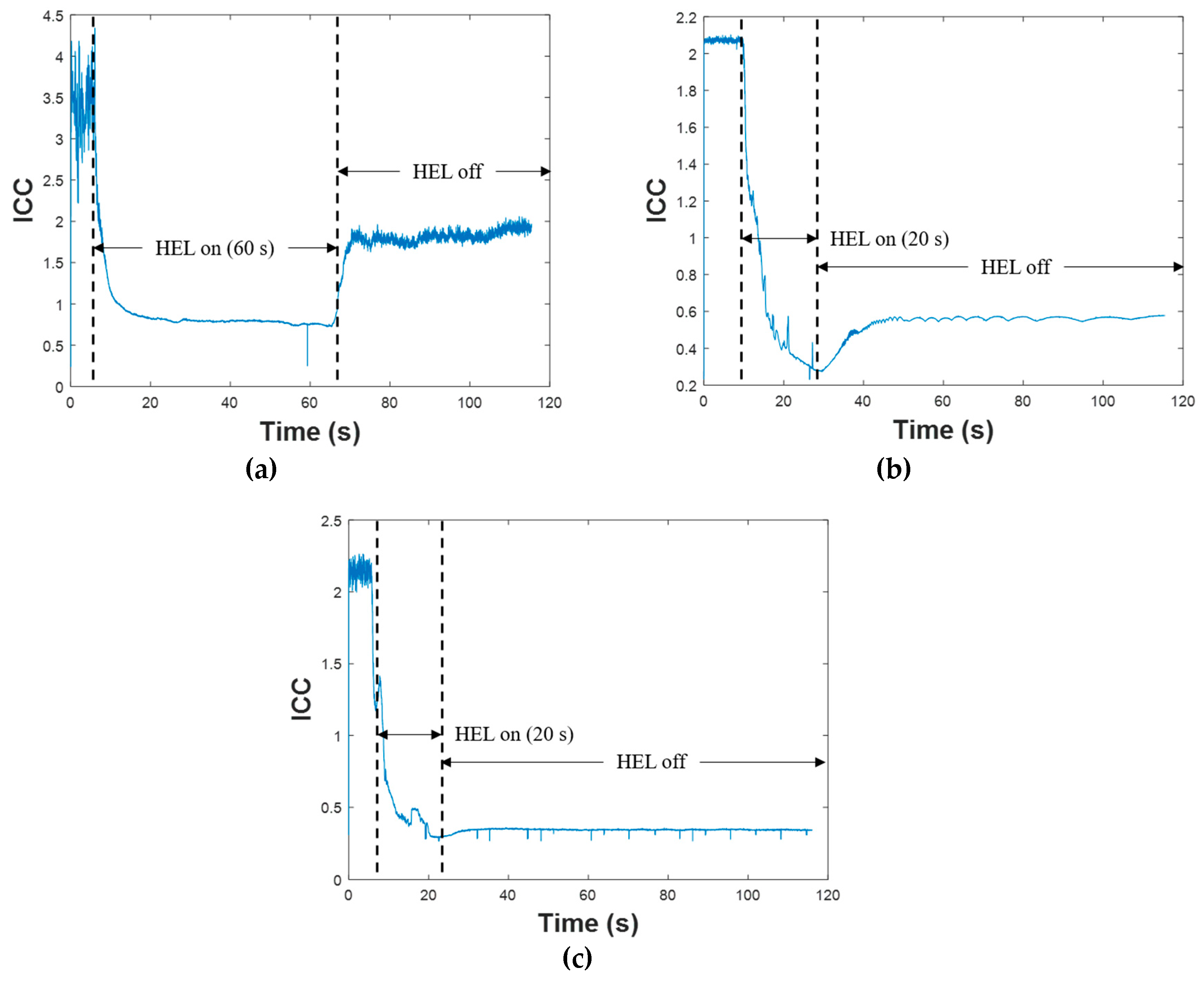High Temperature Effects during High Energy Laser Strikes on Embedded Fiber Bragg Grating Sensors
Abstract
:1. Introduction
2. FBG High Temperature Theory
3. FBG Fabrication
4. Experimental Setup
5. FBG Decay Results
6. Conclusions
Author Contributions
Funding
Acknowledgments
Conflicts of Interest
References
- Maaskant, R.; Alavie, T.; Measures, R.M.; Tadros, G.; Rizkalla, S.H.; Guha-Thakurta, A. Fiber-optic Bragg Grating Sensors for Bridge Monitoring. Cem. Concr. Compos. 1997, 19, 21–33. [Google Scholar] [CrossRef]
- Hill, K.O.; Fujii, Y.; Johnson, D.C.; Kawasaki, B.S. Photosensitivity in optical fiber waveguides: Application to reflection filter fabrication. Appl. Phys. Lett. 1978, 32, 647–649. [Google Scholar] [CrossRef]
- Hill, K.O.; Meltz, G. Fiber Bragg Grating Technology Fundamentals and Overview. J. Lightwave Technol. 1997, 15, 1263–1276. [Google Scholar] [CrossRef]
- Botsis, J.; Humbert, L.; Colpo, F.; Giacarri, P. Embedded fiber Bragg grating sensor for internal strain measurements in polymeric materials. Opti. Lasers Eng. 2005, 43, 491–510. [Google Scholar] [CrossRef]
- Harris, J.; Barjasteh, E. Integration of fiber Bragg grating optic sensors for strain detection in structures composed of CFRP composite. Proc. SPIE 2017, 10170, 101703C. [Google Scholar]
- Du, W.; Tao, X.M.; Tam, H.Y.; Choy, C.L. Fundamentals and applications of optical fiber Bragg grating sensors to textile structural composites. Compos. Struct. 1998, 42, 217–229. [Google Scholar] [CrossRef]
- Krohn, D.; Nichols, P. Fiber Optic Sensor Applications in Transportation Infrastructure Protection. Proc. SPIE 2009, 7314, 73140. [Google Scholar]
- Moyo, P.; Brownjohn, J.M.W.; Suresh, R.; Tjin, S.C. Development of fiber Bragg grating sensors for monitoring civil infrastructure. Eng. Struct. 2005, 27, 1828–1834. [Google Scholar] [CrossRef]
- Takahashia, I.; Sekine, K.; Takeya, H.; Iwahori, Y.; Takeda, N.; Koshioka, Y. Life Cycle Structural Health Monitoring of Airframe Structures: Strain Mapping using FBG Sensors. In Proceedings of the SPIE Smart Structures and Materials & Nondestructive Evaluation and Health Monitoring, San Diego, CA, USA, 11–15 March 2012. [Google Scholar]
- Al-Tarawneh, M.; Huang, Y. In-pavement fiber Bragg grating sensors for high-speed weigh-in-motion measurements. In Proceedings of the 2017 SPIE Smart Structures and Materials & Nondestructive Evaluation and Health Monitoring, Portland, OR, USA, 25–29 March 2017. [Google Scholar]
- Kasper, J.C.; Wiggenhorn, M.; Resch, M.; Friess, W. Implementation and evaluation of an optical fiber system as novel process monitoring tool during lyophilization. Eur. J. Pharm. Biopharm. 2013, 83, 449–459. [Google Scholar] [CrossRef] [PubMed]
- Huang, Y.; Fang, X.; Bevans, W.J.; Zhou, Z.; Xiao, H.; Chen, G. Large-strain optical fiber sensing and real-time FEM updating of steel structures under the high temperature effect. Smart Mater. Struct. 2012, 22, 1–13. [Google Scholar] [CrossRef]
- Torres Górriz, B.; Payá-Zaforteza, I.; Calderón García, P.A.; Sales Maicas, S. New fiber optic sensor for monitoring temperatures in concrete structures during fires. Sens. Actuators A Phys. 2017, 254, 116–125. [Google Scholar] [CrossRef]
- Inaudi, D.; Glisic, B. Long-Range Pipeline Monitoring by Distributed Fiber Optic Sensing. J. Press. Vessel Technol. 2010, 132, 011701–01–011701–09. [Google Scholar] [CrossRef]
- Jenkins, R.B.; Joyce, P.; Mechtel, D.; Milden, K.; Elam, K.; Watkins, R.J. Highly localized thermal response measurements in composites using embedded fiber Bragg grating temperature sensors. In Proceedings of the 2013 SPIE Smart Structures and Materials & Nondestructive Evaluation and Health Monitoring, San Diego, CA, USA, 10–14 March 2013. [Google Scholar]
- Jenkins, R.B.; Joyce, P.; Mechtel, D. Localized temperature variations in laser irradiated composites with embedded fiber Bragg grating sensors. Sensors 2017, 17, 251. [Google Scholar] [CrossRef] [PubMed]
- Erdogan, T.; Mizrahi, V.; Lemaire, P.J.; Monroe, D. Decay of ultraviolet-induced fiber Bragg gratings. J. Appl. Phys. 1994, 76, 73–80. [Google Scholar] [CrossRef]
- Åslund, M.L.; Canning, J.; Stevenson, M.; Cook, K. Thermal stabilization of Type I fiber Bragg gratings for operation up to 600 °C. Opt. Lett. 2010, 35, 586–588. [Google Scholar] [CrossRef] [PubMed]
- Holmberg, P.; Fokine, M. Thermometric study of CO2-laser heated optical fibers in excess of 1700 °C using fiber Bragg gratings. J. Opt. Soc. Am. B 2013, 30, 1835–1842. [Google Scholar] [CrossRef]
- Jenkins, R.B.; Joyce, P.; Nelson, C.; Kautzman, M. Response of an embedded distributed optical fiber sensor to directed energy and applied strain. In Proceedings of the 2018 SPIE Smart Structures and Materials & Nondestructive Evaluation and Health Monitoring, Denver, CO, USA, 4–8 March 2018. [Google Scholar]
- Jenkins, R.B.; Joyce, P.; Kong, A.; Nelson, C. Discerning localized thermal impulses using an embedded distributed optical fiber sensor network. In Proceedings of the 2019 SPIE Smart Structures and Materials & Nondestructive Evaluation and Health Monitoring, Denver, CO, USA, 3–7 March 2019. [Google Scholar]
- Ross, M.J.; Nelson, C.; Jenkins, R.B.; Joyce, P. Effects of High Energy Laser Strikes on Embedded Fiber Bragg Grating Sensors. In Proceedings of the 2017 Directed Energy Systems Symposium, Monterey, CA, USA, 25–29 September 2017. [Google Scholar]
- Baker, S.R.; Rourke, H.N.; Baker, V.; Goodchild, D. Thermal Decay of Fiber Bragg Gratings Written in Boron and Germanium Codoped Silica Fiber. J. Lightwave Technol. 1997, 15, 1470–1477. [Google Scholar] [CrossRef]








| Parameter | Value |
|---|---|
| (1.86 ± 0.22) × 10−3 | |
| (7.64 ± 0.19) × 10−3 | |
| 1 min | |
| 5250 ± 250 K |
| FBG | Test | (dB) |
|---|---|---|
| A | 1 | −21.61 |
| B | 2 | −11.93 |
| C | 3 | −13.32 |
| FBG | Test | Laser Power (W) | Time on Target (s) | N2 Used? | FBG Degradation Level |
|---|---|---|---|---|---|
| A | 1 | 25 | 60 | Yes | Slight |
| B | 2 | 100 | 20 | Yes | Moderate |
| C | 3 | 100 | 20 | No | Severe |
| Test 1 | Test 2 | Test 3 | Ref. [17] | |
|---|---|---|---|---|
| Damage | Slight | Moderate | Severe | Varies |
| 1.536 s | 2.219 s | 1.8232 s | N/A: constant | |
| 9.86 × 10−3 | 6.80 × 10−3 | 1.96 × 10−2 | (1.86 ± 0.22) × 10−3 | |
| 9.00 × 10−3 | 2.74 × 10−3 | 4.40 × 10−3 | (7.64 ± 0.19) × 10−3 |
© 2019 by the authors. Licensee MDPI, Basel, Switzerland. This article is an open access article distributed under the terms and conditions of the Creative Commons Attribution (CC BY) license (http://creativecommons.org/licenses/by/4.0/).
Share and Cite
Ross, M.J.; Jenkins, R.B.; Nelson, C.; Joyce, P. High Temperature Effects during High Energy Laser Strikes on Embedded Fiber Bragg Grating Sensors. Sensors 2019, 19, 1432. https://doi.org/10.3390/s19061432
Ross MJ, Jenkins RB, Nelson C, Joyce P. High Temperature Effects during High Energy Laser Strikes on Embedded Fiber Bragg Grating Sensors. Sensors. 2019; 19(6):1432. https://doi.org/10.3390/s19061432
Chicago/Turabian StyleRoss, Michael J., R. Brian Jenkins, Charles Nelson, and Peter Joyce. 2019. "High Temperature Effects during High Energy Laser Strikes on Embedded Fiber Bragg Grating Sensors" Sensors 19, no. 6: 1432. https://doi.org/10.3390/s19061432
APA StyleRoss, M. J., Jenkins, R. B., Nelson, C., & Joyce, P. (2019). High Temperature Effects during High Energy Laser Strikes on Embedded Fiber Bragg Grating Sensors. Sensors, 19(6), 1432. https://doi.org/10.3390/s19061432





